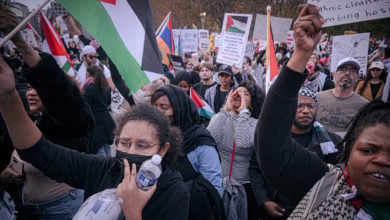On July 20, 10 days into Israel’s massive bombardment of Lebanon, the U.S. House of Representatives passed, by a vote of 410-8, a resolution to “recognize Israel’s longstanding commitment to minimizing civilian loss and welcome Israel’s continued efforts to prevent civilian casualties.” Nearly all Democrats as well as Republicans voted for that grotesque and cynical measure.
On Sept. 16, at a news conference in Beirut, it was revealed that Israel rained at least 350,000 cluster bomblets—and
|
David Shearer, UN humanitarian coordinator for Lebanon, told the press conference: “The outrageous fact is that nearly all of these munitions were fired in the last three to four days of the war. Outrageous because by that stage the conflict had been largely resolved in the form of (UN Security Council) Resolution 1701.”
Many cluster bomblets are contained in a cluster bomb or artillery shell. They are dispersed over a wide area when the bomb or shell explodes. The bomblets are about the size of a hand grenade, and often packed with razor-sharp pieces of metal. Simply touching or picking them up can cause detonation.
Cluster bombs have killed or wounded an average of three people a day since the war ended, according to the United Nations As of Sept. 16, 15 people had been killed by the bomblets, including a child, and 83 more had been wounded, 23 of whom are children.
Cluster bombs are a truly indiscriminate weapon, the aim of which is to kill or maim as many people as possible in the area where they are detonated, regardless of their status as a combatant or non-combatant.
As of mid-September, the United Nations had identified more than 500 cluster bomb strike locations in southern Lebanon and was finding more every day.
U.S.-Israeli war crimes
At least 200,000 Lebanese are unable to return to their homes and farms. Most of the people in the area depend on farming for their livelihood. It is estimated that hundreds of thousands of bomblets are scattered across farmlands. They are extremely difficult to locate in fields where the crops are ripe, so harvesting has been made impossibly dangerous in many areas.
The United Nations reports state that 30 to 40 percent of the bomblets the Israelis scattered over the south failed to explode. As of mid-September, only 17,000 bomblets have been defused. The defusing work is very hazardous. Several people have been killed clearing the bomblets and several more seriously wounded. Estimates for how long it will take to complete the work range from three to 10 years.
Israel has refused to provide any information on the targeting of its shelling and bombing, despite repeated requests from Lebanese and UN officials. Israeli officials have also refused to give any explanation for the massive use of weapons targeting civilians, especially as the fighting was coming to an end.
Contrary to the absurd assertions of the July 20 House of Representatives resolution, Israel waged a war of terror against the people of Lebanon—but not by itself.
The U.S. government provided emergency re-supply of cluster bombs and other munitions, as well as jet fuel and the planes that enabled Israel to carry out 4,500 bombing raids against a country with no anti-aircraft defenses.
Of the 1,289 Lebanese killed, at least 85 percent were civilians. Of the 160 Israelis killed in the war, 74 percent were soldiers. Facts, not propaganda assertions, demonstrate who in reality was indiscriminately targeting civilians.
The intentional targeting of a civilian population is a war crime under international law, and the governments of both the United States and Israel should be tried and convicted for their crimes.
But don’t hold your breath. The international legal system is operated much like the one inside this country—by the rich against the poor.







